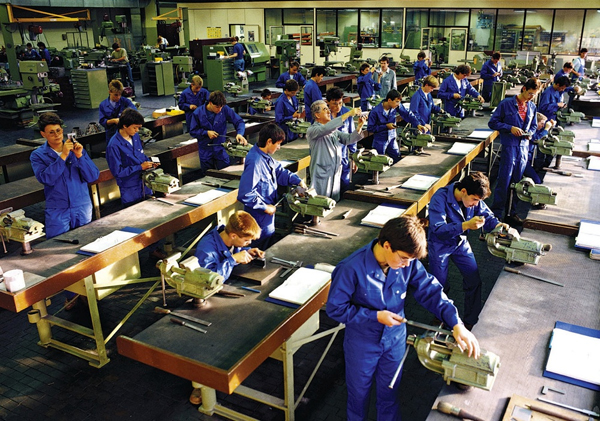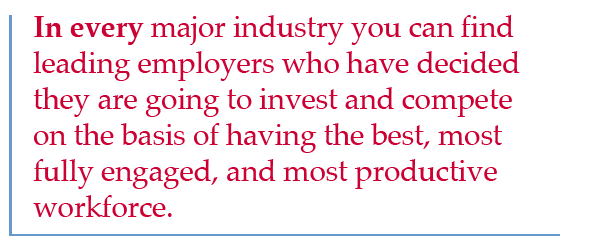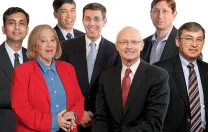An interview with Thomas A. Kochan, Bunker professor of management, MIT’s Sloan School of Management, and co-director of the MIT Institute for Work and Employment Research. Read the complete article, "Can America Compete?" (September-October 2012)
Harvard Magazine: You speak of a fundamental human-capital paradox in the way American employers and workers interact with each other.
Thomas Kochan: American corporations often say human resources are their most important asset. In our national discourse, everyone talks about jobs. Yet as a society we somehow tolerate persistent high unemployment, 30 years of stagnating wages and growing wage inequality, two decades of declining job satisfaction and loss of pension and retirement benefits, and continuous challenges from the consequences of unemployment on family life. If we really valued work and human resources, we would address these problems with the vigor required to solve them.
HM: What causes this disconnection?
TK: The root cause is that we have become a financially driven economy. The view of shareholder value as corporations’ primary objective has dominated since the 1980s. That motivation—to get short-term shareholder returns—then pushes to lower priority all the other things we used to think about as a social contract: that wages and productivity should go together, that there should be an alignment between the interest of American business and the overall American economy and society. That creates a market failure: it’s not in the interest of an individual firm to address all of the consequences of unemployment and loss of high-quality jobs, but the business community overall depends on high-quality jobs to produce the purchasing power needed to sell their goods and services to the American market. Sixty percent of U.S.-based multinational corporations’ revenue still comes from the U.S. market. We’ve got to solve this market failure.
But I think there is also a deep institutional failure in the United States. We have allowed the labor movement and the government and our educational institutions—the coordinating glue that brought these different interests together and provided some assistance in coordinating economic activity—all to decline in effectiveness. Government is completely polarized and almost impotent at the moment. Unions have declined to the point where they are no longer able to discipline management or serve as a powerful and valued partner with business to solve problems. And I’m concerned that our business schools particularly have receded into the same myopic view of the economic system where finance rules everything, so we aren’t training the next generation of leaders to manage businesses in ways that work for both investors and shareholders and for employees in the community.
HM: Is there a jobs crisis?
TK: There’s a crisis with two dimensions. First, we still have not recovered from the last recession: we’re still about five million jobs short of getting back to where we were. The best estimate is that it’s going to take us the rest of this decade and we’re going to have to create about 20 million jobs to make up for those lost and for the growth in the labor force. That computes to about 200,000 jobs a month, and we’re not even coming close.
The second element of the crisis has been going on since 1980. Wages for average workers have been stagnant, so we have seen both the growth in inequality (as a high proportion of the income gets distributed to the top 5 percent or 1 percent of the population) and we have seen a gap develop between wage growth and productivity growth. From the 1940s through the 1970s, we had an implicit social contract where they moved in tandem. That broke down: since 1980 we’ve had about 84 percent growth in productivity but only 10 percent growth in median family income and 5 percent growth in wages. We’ve got to address both dimensions of this crisis to get the economy back on track.
HM: What has happened to the quality of jobs and the match with workers’ skills?
TK: An average employee who gets laid off from a good manufacturing or service job at age 45 is likely not only to experience extended unemployment but to take a loss in wages when he or she finally gets reemployed. The average employee loses between 15 and 20 percent. Those who don’t find another job and have to retire early, or drop out of the labor force, or go back to school, obviously have deeper losses. They are likely to be unemployed longer today than they were in the past; over 40 percent of those who are unemployed are unemployed for more than six months—a long time to be without a living wage. They also bear the social costs of unemployment in terms of impacts on families, health, divorce rates, suicide, even mortality. There’s evidence that those unemployed for a long time have a lower life expectancy. Children of unemployed parents don’t learn as well in school.
As for employers, we have this paradoxical situation where some say they can’t find the skilled workers they need. That in part reflects changes in technologies and in industry and product mix in the U.S. as employers try to transform to a higher value-added economy—to a more high-technology-, social-media-oriented economy. The technical and behavioral skills, problem-solving skills, analytical skills are all in very high demand—and those are not necessarily the skills of the prior generation. So while we are producing young people with many of these skills, many of the unemployed don’t have what is needed. This problem is entirely solvable for those already in the workplace and young students alike. We just have to rebuild and expand apprenticeships, get more community colleges working closely with industry, and adapt our education system (K-12 and our four-year universities) to make sure that we get more of our young people into the STEM fields—science, technology, engineering, and math disciplines that are in high demand.

Photograph by Maximilian Stock Ltd/Corbis Images
Metalwork training at a vocational school in Germany, a high-wage, manufacturing powerhouse--and a model of skills- and job-focused training that U.S. employers and educators might want to emulate
HM: Where does the responsibility for that training lie?
TK: The good news is, people are beginning to recognize that we have a crisis. The bad news is, we don’t have leadership yet that has stepped forward to say we’re going to bring these groups together to solve the market failure and rebuild our institutions to get the job done.
Business schools have not only a special opportunity but a responsibility to do so. We know how to bring groups together, we teach multiparty negotiations and collaborative problem-solving, we teach leadership. It’s time for us to say to American industry leaders, labor leaders, and our community colleges: Let’s get together and identify, within our respective regions, what skills you need. How can we contribute to making sure that the four-year universities are providing the right mix of skills? How can we build more internships and co-op programs with you and use our online-learning technologies to retrain or give second-chance education to people who have the intellectual capabilities needed to learn these skills? How can we learn from the best examples? There are many: from North Carolina’s community colleges to Wisconsin, where there are very good technical schools linked to local industry—whether manufacturing or advanced information technology or healthcare. We need to make sure we’re working with state-of-the-art technologies and job specifications and that employers are engaged collectively so they share the cost but can also share the benefits by hiring the graduates.
That’s not rocket science, that’s leadership and institution-building. We could do that—we don’t have to wait for a big government program (although I do think the federal government has an opportunity and responsibility as well).
HM: In the finance-driven model of business, it is perhaps easiest to treat everything as a cost. What about the alternative that invests in human capital and considers workers a source of innovation and service enhancement—competing on the basis of product development, innovation, and quality?
TK: There’s good news on this front as well. In every major industry you can find leading employers who have decided they are going to invest and compete on the basis of having the best, most fully engaged, and most productive workforce—characteristics that support the higher-wage profile.

The favorite example is Southwest Airlines. Their business model is not to compete on the basis of lowest labor cost but keeping their unit cost low and their productivity high by turning their planes around more rapidly than any competitors: they make money by flying planes rather than having them sit on the tarmac. To do that, they have to select people who are capable of working in teams and motivated to work together. They have to train people. They have to have union contracts that don’t have a lot of cumbersome work rules, so they get the flexibility to work together to solve problems. They have produced high levels of profits and good wages, and for the last two decades have always been on the Fortune list of the 100 best places to work.
We need to learn from those examples: Southwest or Continental airlines; Kaiser Permanente in healthcare—they have an advanced partnership with their employees and unions and are way ahead on automated medical records and teamwork among doctors, nurses, and technicians. In manufacturing, there are examples in the steel and automobile industries of how to do this.
But we aren’t making those the norm. We should make sure no one comes out of our universities to be a future business leader, an entrepreneur, or even a middle manager, who doesn’t have the skills and knowledge to build these “high-performance” work systems, as they’re called, and who sees that as a way to compete that works for both shareholders and the workforce.
HM: What does that model imply for workers and unions?
TK: If unions want to have a future in the United States, they need to be the champions of giving workers the training, skills, and opportunities to add value to their enterprise—and then be able to negotiate a fair sharing of the returns that they help to generate. That’s how labor unions could add considerable value and discipline management—in a way that works for the benefit of the firm as well as for the workforce. Workers should be demanding that of their employer, their union, their professional association. They should be demanding that in their university education—skills that prepare them to add value in these ways and to lead others so everyone is adding value. That way, we can compete effectively, with a high-quality American workforce.
HM: Are there implications for other levels of education?
TK: The best elementary and secondary schools now educate young people to be more skilled in working together (with team assignments), in communications and problem-solving, even in negotiations and conflict-resolution. We need to get that curriculum embedded all over the country: strengthening math and science and these behavioral skills. Universities are doing a lot more of this. At MIT, we’re exposing our fantastic engineering and science undergraduates to leadership, problem-solving, negotiations, how real organizations work—how to sell their creative, technical ideas to people in authority. But we have a long way to go. We’re farther along with undergraduates than with graduate students—particularly in the business and professional schools.
HM: In human development, are companies disproportionally spending on upper management, as opposed to “middle skills”—the operating skills that used to be taught in apprenticeships?
TK: It’s a gross misallocation of resources to spend millions on executive education for middle managers or senior executives while systematically underinvesting in people who develop the products, manufacture them, and service them. These middle skills are eroding because firms have given up on training. They expect to be able to buy all these skills on the market, and don’t want to invest in training because they’re afraid if they do their competitors will hire these newly minted high-skills employees away. Employers need to reinvest by engaging each other in their industry, in their location, sharing the cost and the benefits. The internship model, the co-op model, the local-industry collaborative that works closely with universities to make sure they’re training and educating people in up-to-date skills and technologies is a model that has proven its effectiveness. We need to multiply those models many times over.
HM: Are other countries doing things better?
TK: The problems are more severe in the U.S. because we have such a tradition of individualism. We don’t have a history of collaborating between labor and management or with other businesses.
Germany has a well-established vocational-education program funded at the regional level; industry is very much involved in shaping the standards and curriculum and hiring the graduates of those programs. We’re not going to have a single system like Germany’s. But the best examples around the country are where local industry works with local education institutions to tailor programs to suit the regional industry mix. That’s why the buzzword is that you have to have an “ecosystem” in the region: Rosabeth Moss Kanter emphasizes this—and she is right to do so (see below). We need to bring education, training, human-resource systems, finance, the supplier community, and the infrastructure together—that’s what we mean by an ecosystem. We’ve got to make sure the workforce is addressed as part of a modern ecosystem for a competitive industry cluster.
The federal government should be a catalyst for this kind of innovation and institution-building. The best analogy I can think of is the model being used in education, with “Race to the Top” funds. Create the same incentives for community colleges, universities, and industry collaborative institutions.
We know there are a couple of key ingredients to successful training and education: the close links between industry and education that we’ve been talking about, and using adult-based learning models with a mix of classroom and on-the-job application through internships, co-ops, or apprenticeships. Third is a career pathway, so there’s a continuous opportunity to progress and to learn. It’s got to be collaborative—engaging the business community, not just an individual firm.
If we say any program that meets those basic principles will get matching funds from the federal government and if you don’t, you won’t, you would see changed behavior at the community level where we need it. Race to the Top has produced enormous national change. The job of the federal government here is to get that same innovation at a scale sufficient to have effects on our overall jobs and economic competitiveness. The federal government doesn’t have to tell you what to train people in or force you to do this. It has to say, “Meet these basic principles in ways that fit your particular circumstances and we will share in the investments—and if you don’t, you’re on your own.”
Next: The Business Ecosystem
“A country can become complacent about its assets.”
Rosabeth Moss Kanter, Arbuckle professor of business administration, in HBS’s general management unit, and chair and director of the Harvard University Advanced Leadership Initiative











